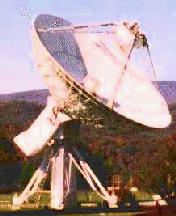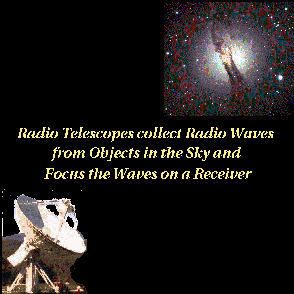Introduction to Science in the Galactic Plane
Lesson 7:The Radio Telescope

 QUESTION: What is a Radio Telescope?
QUESTION: What is a Radio Telescope?
Radio telescopes collect radio waves from astronomical sources, such as Supernovas, Star forming regions, pulsars, black holes at the centers of distant galaxies, and the background emission from the Big Bang. Radio telescopes work in a similar manner to optical telescopes, by collecting radio wavelength light and focusing it on the detector. For optical telescopes, the detectors are your eye, photographic film or a CCD camera. For radio telescopes, the receiver is the combination of a feed antenna, amplifiers and a power detector. Radio telescopes measure the power from the radio sources as a function of position around the source and as a function of radio wavelength to make a spectrum.
The Galactic Plane A (GPA) survey uses the 45 foot (13.6 meter) diameter radio telescope in Green Bank, West Virginia to map the Milky Way Galaxy. In this lesson, the student is shown how a radio telescope collects radio waves and focuses them on the receiver.
The Perfect Shape: A ParabolaMost large Radio and Optical telescopes have large parabolic surfaces (mirrors) which focus the radio and light waves onto a detector. The large surface is needed to collect the very faint signals for detection by a receiver. The sensitivity of a radio telescope increases linearly with the surface area of the primary reflector. A simple formula relates the resolution of the telescope to its size, measured in WAVE-LENGHTs. The angular resolution, THETA, of the telescope increases linearly with the DIAMETER of the telescope. Smaller resolution (smaller THETA) means that smaller structures can be seen (smaller is better).
Where the THETA is measured in RADIANS. To convert from RADIANS to DEGREES, multiply by 57.3. |

|
|
|
|
|
| Previous | Up | Next |
2000-08-10